ship
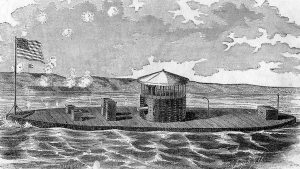 The worst fate a ship can suffer is to end up at the bottom of the sea. Nevertheless, it is a hazard that goes with the territory. Most of these lost ships simply litter the ocean floor, never seeing the light of day again, but once in a while, a ship…or part of a ship finds itself being raised up from the bottom again. Such was the case with USS Monitor, a Civil War era naval warship, that sunk to a watery grave in a storm on March 9, 1862, taking with it, 16 members of it’s crew, who were afraid to go topside in the storm.
The worst fate a ship can suffer is to end up at the bottom of the sea. Nevertheless, it is a hazard that goes with the territory. Most of these lost ships simply litter the ocean floor, never seeing the light of day again, but once in a while, a ship…or part of a ship finds itself being raised up from the bottom again. Such was the case with USS Monitor, a Civil War era naval warship, that sunk to a watery grave in a storm on March 9, 1862, taking with it, 16 members of it’s crew, who were afraid to go topside in the storm.
A short nine months before the tragedy of the USS Monitor, the ship had been part of a revolution in naval warfare. On March 9, 1862, it dueled to a standstill with the CSS Virginia in one of the most famous moments in naval history. It was the first time two ironclads ships faced each other in a naval engagement. During the battle, the two ships circled one another, jockeying for position as they fired their guns, but the cannon balls were no match for the ironclad ships, and they simply deflected off of the sides. In the early afternoon, the Virginia pulled back to Norfolk. Neither ship was seriously damaged, but the Monitor effectively ended the short reign of terror that the Confederate ironclad had brought to the Union navy. What a strange battle that must have been.
The USS Monitor was designed by Swedish engineer John Ericsson. Probably the most strange part of the design was the fact that Monitor had an unusually low profile, rising from the water only 18 inches. The ship sat so low to the water, that it could easily have resembled a submarine. The flat iron deck had a 20 foot cylindrical  turret rising from the middle of the ship. The turret housed two 11 inch Dahlgren guns. The shift had a draft of less than 11 feet so it could operate in the shallow harbors and rivers of the South. It was commissioned on February 25, 1862, and arrived at Chesapeake Bay just in time to engage the Virginia. After the famous duel with the CSS Virginia, the Monitor provided gun support on the James River for George B. McClellan’s Peninsular Campaign. By December 1862, it was clear the ship was no longer needed in Virginia, so she was sent to Beaufort, North Carolina, to join a fleet being assembled for an attack on Charleston.
turret rising from the middle of the ship. The turret housed two 11 inch Dahlgren guns. The shift had a draft of less than 11 feet so it could operate in the shallow harbors and rivers of the South. It was commissioned on February 25, 1862, and arrived at Chesapeake Bay just in time to engage the Virginia. After the famous duel with the CSS Virginia, the Monitor provided gun support on the James River for George B. McClellan’s Peninsular Campaign. By December 1862, it was clear the ship was no longer needed in Virginia, so she was sent to Beaufort, North Carolina, to join a fleet being assembled for an attack on Charleston.
The Monitor was an ideal type of ship in the sheltered waters of Chesapeake Bay, but the heavy, low-slung ship was no good in the open sea. Knowing that, the USS Rhode Island towed the ironclad around the rough waters of Cape Hatteras…a plan that would prove disastrous. As the Monitor pitched and swayed in the rough seas, the caulking around the gun turret loosened and water began to leak into the hull. More leaks developed as the journey continued. High seas tossed the craft, causing the ship’s flat armor bottom to slap the water. Each roll opened more seams, and by nightfall on December 30, it was clear that the Monitor was going to sink. That evening, the Monitor’s commander, J.P. Bankhead, signaled the Rhode Island that they needed to abandon ship. The USS Rhode Island pulled as close as safety allowed to the stricken USS Monitor, and two lifeboats were lowered to retrieve the crew. Many of the sailors were rescued, but some men were too terrified to venture onto the deck in such rough seas. The Monitor’s pumps stopped working, and the ship sank before 16 of its crew members could be rescued. It amazes me that a ship that could deflect cannon balls, was taken  down by loosened calking.
down by loosened calking.
On this day in 2002, the rusty iron gun turret of the USS Monitor rose up from the bottom of its watery grave, and into the daylight for the first time in 140 years. The ironclad warship was raised from the floor of the Atlantic, where it had rested since it went down in a storm off Cape Hatteras, North Carolina, during the Civil War. Divers had been working for six weeks to bring it to the surface. The remains of two of the 16 lost sailors were discovered by divers during the Monitor’s 2002 reemergence. Many of the ironclad’s artifacts are now on display at the Mariners’ Museum in Newport News, Virginia.
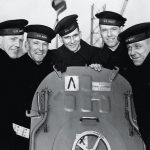 These days, it is rare to have siblings serving on the same post…much less the same ship. Nevertheless, it was a practice that did take place in the past. In fact, in the case of the USS Juneau, five brothers were all serving together on the ship. It was the height of World War II, and it was imperative that every available man was out there fighting. The Sullivan brothers, Francis Henry, George Thomas, Joseph Eugene, Madison Abel, and Albert Leo enlisted in the navy on January 3, 1942, with the stipulation that they all serve together on the same ship. The Navy had a policy of separating siblings, but this was not strictly enforced. Two brothers, George and Frank had served in the Navy before, but their brothers had not. All five were assigned to the light cruiser USS Juneau.
These days, it is rare to have siblings serving on the same post…much less the same ship. Nevertheless, it was a practice that did take place in the past. In fact, in the case of the USS Juneau, five brothers were all serving together on the ship. It was the height of World War II, and it was imperative that every available man was out there fighting. The Sullivan brothers, Francis Henry, George Thomas, Joseph Eugene, Madison Abel, and Albert Leo enlisted in the navy on January 3, 1942, with the stipulation that they all serve together on the same ship. The Navy had a policy of separating siblings, but this was not strictly enforced. Two brothers, George and Frank had served in the Navy before, but their brothers had not. All five were assigned to the light cruiser USS Juneau.
I stumbled upon the story of the five Sullivan brothers on the Find a Grave site while looking for disaster losses. Every time I have found numerous deaths in the same family, I have been surprised and shocked. Mostly, they have occurred because of some illness like typhoid fever, the plague, or some other illness, and those are all really sad, especially when it is a disease we can cure now. This was different, however. The Sullivan brothers were 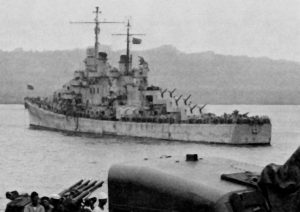 not sick…there was no epidemic, this was war. This simply a demonstration of why brothers were not normally on the same ship.
not sick…there was no epidemic, this was war. This simply a demonstration of why brothers were not normally on the same ship.
The Juneau engaged in a number of battles during the months of the Guadalcanal Campaign which began in August 1942. Early in the morning of November 13, 1942, during the Naval Battle of Guadalcanal. The Juneau was struck by a Japanese torpedo and forced to withdraw. Later that day, it was leaving the Solomon Islands’ area for the Allied rear area base at Espiritu Santo with other surviving United States warships, when the Juneau was struck again, this time by a torpedo from Japanese submarine I-26. The torpedo most likely hit the thinly armored light cruiser at or near the ammunition magazines and the ship exploded and quickly sank. The Helena and San Francisco, who were also in the area, but they had assumed that there were no survivors, and quickly departed without attempting to rescue any of the survivors.
More than 100 sailors survived the sinking of Juneau, but they were left to fend for themselves in the open ocean for eight days before rescue aircraft finally arrived. While awaiting rescue, all but 10 died from the elements and shark attacks, including the five Sullivan brothers. Two of the brothers apparently 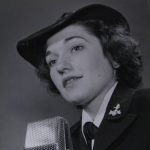 survived the sinking, only to die in the water. Two others presumably went down with the ship. Some reports indicate the fifth brother also survived the sinking, but disappeared during the first day in the water. On 20 November 1942, USS Ballard recovered two of the ten survivors. They were found in separate rafts, five miles apart. One of the survivors recovered by Ballard stated he had been with one of the Sullivan brothers for several days after the sinking. In that one day, Thomas and Alleta Abel Sullivan, lost all five of their sons. They were left only with their daughter, Genevieve Marie Sullivan Davidson. Their other daughter, Kathleen Sullivan had died at birth. Amazingly, daughter Genevieve decided to serve in the Navy too, as a Wave. While she survived her service, I’m sure her parents, while proud of her, were tormented by her decision.
survived the sinking, only to die in the water. Two others presumably went down with the ship. Some reports indicate the fifth brother also survived the sinking, but disappeared during the first day in the water. On 20 November 1942, USS Ballard recovered two of the ten survivors. They were found in separate rafts, five miles apart. One of the survivors recovered by Ballard stated he had been with one of the Sullivan brothers for several days after the sinking. In that one day, Thomas and Alleta Abel Sullivan, lost all five of their sons. They were left only with their daughter, Genevieve Marie Sullivan Davidson. Their other daughter, Kathleen Sullivan had died at birth. Amazingly, daughter Genevieve decided to serve in the Navy too, as a Wave. While she survived her service, I’m sure her parents, while proud of her, were tormented by her decision.
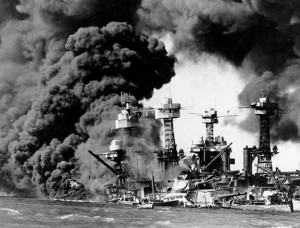
 Located in the middle of Pearl Harbor is an island 335 acres in size. In Hawaii’s early days, it was known as Mokuumeume, meaning Island of Strife. It amazes me just how close that name is to the reality that is the island that is now known as Ford Island. I don’t think that strife is a constant companion of the island, but on this day, December 7, 1941…the date that will live in infamy, Ford Island was at center stage as one of the worst attacks in history took place on American soil. The participants, from the American side anyway, would have most certainly have chosen not to be there…if they had been given a choice. The island had changed hands several times, before finally ending up as a part of the military installation that was Pearl Harbor.
Located in the middle of Pearl Harbor is an island 335 acres in size. In Hawaii’s early days, it was known as Mokuumeume, meaning Island of Strife. It amazes me just how close that name is to the reality that is the island that is now known as Ford Island. I don’t think that strife is a constant companion of the island, but on this day, December 7, 1941…the date that will live in infamy, Ford Island was at center stage as one of the worst attacks in history took place on American soil. The participants, from the American side anyway, would have most certainly have chosen not to be there…if they had been given a choice. The island had changed hands several times, before finally ending up as a part of the military installation that was Pearl Harbor.
Every year, as Pearl Harbor Remembrance Day comes around, I try to write a story about that dreadful day, and this year, while looking at Pearl Harbor on Google Earth, my thoughts turned to that little island that was at the center of the attack. How must those men have felt? Everything happened so fast. There wasn’t even time to get the planes in the air. While the ships were being bombed around them, the pilots, mechanics, and airfield crew could only stand around watching…and dodging bullets. Of course, for most of them, that was impossible. The death toll that horrific day was 2403. In addition, there were 1178 people wounded. The emotional toll was beyond the imagination. This was the event that finally brought the United States into World War II.
I began to wonder what the people who were there were thinking as the events of the attack unfolded. There was no way to get off the island. If they had tried, they would surely have been killed. There were bombs going off on all sides of the island. Ships were sinking, airplanes were destroyed, and buildings were on fire or blown up. It was as if the world was coming to an end…or in reality, it was like waking up and finding yourself literally in Hell. My mind struggled to imagine how they must have felt…wishing and praying that all this was a dream and that they could be somewhere else…anywhere else. Still, they knew that it was real, and they were there, and 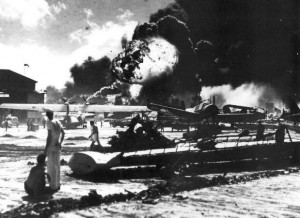
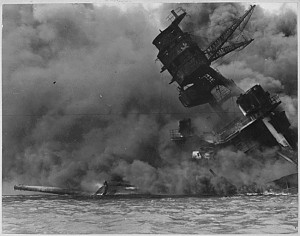 nothing would ever be the same again. They knew that the world as they had known it, had vanished…never to exist again. Of course, our country would come back from this attack, because we are a resilient people, but we would never be the same. We were less trusting of our enemies, something I see again in this day and age of terrorism, and something I think is important.
nothing would ever be the same again. They knew that the world as they had known it, had vanished…never to exist again. Of course, our country would come back from this attack, because we are a resilient people, but we would never be the same. We were less trusting of our enemies, something I see again in this day and age of terrorism, and something I think is important.
Being too trusting of our enemies in December of 1941, was exactly what paved the way for a surprise attack on December 7, 1941, and being too trusting today could do the same thing. It is imperative that we protect our people at all costs…even if it makes us seem heartless now. As in the case of the attack on Pearl Harbor, second chances at protecting our people don’t usually come. By the time we realize that we have made a mistake, it is too late, because it has become a fatal mistake. The men and women who survived the attack on Pearl Harbor knew first hand that our enemies hate us and want nothing less that death for America. That, I believe is the valuable lesson the people who survived that horrific attack took away that fateful day, and one we all need to seriously consider today.
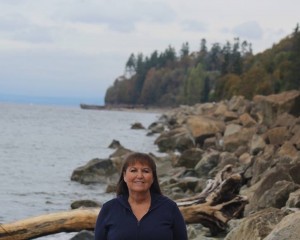 When my daughter, Amy Royce and her family first moved to the Seattle, Washington area, I started looking around online to see what sights there might be for them to go visit. The first thing I came across was the Pacific Queen shipwreck. I was excited to tell them about a shipwreck in their area. I thought it might be a cool thing to go see. Amy researched it too, and found that it was on a private beach. We were disappointed, but I couldn’t get it off my mind.
When my daughter, Amy Royce and her family first moved to the Seattle, Washington area, I started looking around online to see what sights there might be for them to go visit. The first thing I came across was the Pacific Queen shipwreck. I was excited to tell them about a shipwreck in their area. I thought it might be a cool thing to go see. Amy researched it too, and found that it was on a private beach. We were disappointed, but I couldn’t get it off my mind.
Bob and I had a little time on Saturday, so we decided to head back out to Puget Sound. I got an idea to see if there was a place where we could actually see the ship, and found that we could see it from Picnic Point Park. While we could not get close to the private beach where the Pacific Queen rests, we were treated to some really good views of the ship, 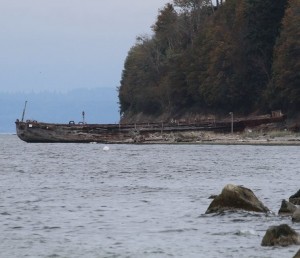 and I was so excited. This was something I really wanted to see.
and I was so excited. This was something I really wanted to see.
I started researching the origins of the Pacific Queen online, I found that she was a old minesweeper. The ship was not wrecked, but rather brought to the site by a man who planned to salvage the metal on her. So the only wreck she had was when she was run aground to her final resting place. The Pacific Queen is one of 27 boats that were brought to the sight over the years, but she is the only one that really still resembles a ship. Several of the boats are underwater except during low tide, and those still look somewhat like ships too.
I admit that I was a little disappointed that it wasn’t an actual shipwreck, but then again, the ship was built in the 1800s. It was actually brought to its current location in 1929, and really has been an area attraction since that time. The best way to get up close is by kayak, but the beach is off limits. Apparently you can walk the distance from Picnic Point Park to the Pacific Queen during the low tide, but it is not recommended that you go onto the actual beach. Nevertheless, a few people have ventured close, and if the owner was in a good mood, they might have been treated to a few of the stories surrounding the boats and their arrival at the current sight.
 In the end, with the boat viewing and my research, I felt very pleased with this adventure. Whether she had wrecked or not, the Pacific Queen was a very cool boat. It was amazing to sit and wonder where she had been and what she and her crews had seen. A minesweeper must have been an important boat, and I would think that would be a dangerous job. If you didn’t see a mine and you bumped into it…well, it was all over for you. Nevertheless, the crews of the Pacific Queen must have been good at their jobs, because she survived the war and ended up on her current resting place, a ship of beauty and intrigue, sought out by many and having her picture on the Internet for all to see. I know that for me, it was a view I will never forget.
In the end, with the boat viewing and my research, I felt very pleased with this adventure. Whether she had wrecked or not, the Pacific Queen was a very cool boat. It was amazing to sit and wonder where she had been and what she and her crews had seen. A minesweeper must have been an important boat, and I would think that would be a dangerous job. If you didn’t see a mine and you bumped into it…well, it was all over for you. Nevertheless, the crews of the Pacific Queen must have been good at their jobs, because she survived the war and ended up on her current resting place, a ship of beauty and intrigue, sought out by many and having her picture on the Internet for all to see. I know that for me, it was a view I will never forget.
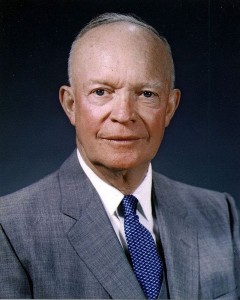 Not all of us can say that we knew a US President, before or during their presidency, but my uncle, Jim Wolfe could say that. Uncle Jim was in the army during World War II, and was on his way to England on a ship. Being the kind of guy who liked to see how things worked, Uncle Jim was laying on the back end of the ship watching the propeller go in and out of the water. Ike came up behind him and asked him if he was sick. Uncle Jim said, “No, I was just watching the prop.” Ike said, “Lord, man I would be so sick it would kill me and I’m on ships all the time.” He told Uncle Jim to come with him and they were going to go to Officers Mess and have coffee. Dad said “I can’t go there I will get in trouble.” Ike informed Uncle Jim that as long as he was with him, they wouldn’t say anything to him.
Not all of us can say that we knew a US President, before or during their presidency, but my uncle, Jim Wolfe could say that. Uncle Jim was in the army during World War II, and was on his way to England on a ship. Being the kind of guy who liked to see how things worked, Uncle Jim was laying on the back end of the ship watching the propeller go in and out of the water. Ike came up behind him and asked him if he was sick. Uncle Jim said, “No, I was just watching the prop.” Ike said, “Lord, man I would be so sick it would kill me and I’m on ships all the time.” He told Uncle Jim to come with him and they were going to go to Officers Mess and have coffee. Dad said “I can’t go there I will get in trouble.” Ike informed Uncle Jim that as long as he was with him, they wouldn’t say anything to him.
In the Officers Mess, Uncle Jim and Ike talked for a long time and then went their separate ways on the ship. When they got to England, Uncle Jim saw him a few times and then on D-Day, they found themselves on the same ship again. When they disembarked, they were under heavy fire, and my cousin Shirley Cameron tells me that Ike got a hold of her dad, my Uncle Jim and asked him how his shooting was. Uncle Jim said that it was good. Ike said, “See that guy in that tree way up there.” Uncle Jim said that he did, and Ike asked if he could hit him. Uncle Jim shot, hit, and killed the man. Ike said for Uncle Jim to stay with him. They were together for quite a while before they got separated. At that point, Uncle Jim was sent to another area.
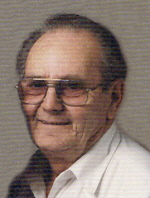
Uncle Jim ended up opening up some of the concentration camps. That was probably the worst part of his service. He said the men were like the walking dead. They were sick, weak, and skinny. All they could do was grab hold of him and thank him over and over for getting them out of that horrible place. Shirley tells me that he saw little wooden sheds that had bodies stacked from bottom to top, There were also pits that had bodies stacked in them ready for the heavy equipment to push the dirt over the top. She told me that experience gave him nightmares for years. He used to have pictures of all of that and the people that they helped out of the camps, but unfortunately they were lost in the fire that destroyed his home a number of years ago. After his time there, Uncle Jim was sent to France to help with the Liberation there. I’m sure he came home with many stories of the war, but as far as I know, that was the last time he ever saw the man who would later become our 34th US President, Dwight D Eisenhower…aka Ike.
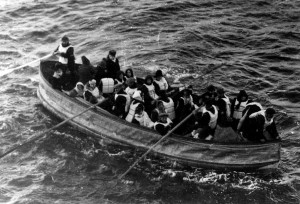 Whenever a big train wreck, plane crash, ship sinking, or other major accident occurs, someone must investigate. Depending on what happened, it can be someone like the NTSB, or in some cases, as in the Titanic sinking, it can go as high as the Senate. Of course, answers need to be found, so that corrections in procedure can be made.
Whenever a big train wreck, plane crash, ship sinking, or other major accident occurs, someone must investigate. Depending on what happened, it can be someone like the NTSB, or in some cases, as in the Titanic sinking, it can go as high as the Senate. Of course, answers need to be found, so that corrections in procedure can be made.
In the case of the Titanic, the accident was brought before the Senate Commerce Committee. I think most of us know the story of the Titanic well, given the movies and documentaries that have come out about it. The official final report, however, went into much more detail than most people know about, and more than I can go into here. I think most of us know that the ship was not sufficiently run through the test trials to properly break in the engines. Nevertheless, the Titanic was run at full speed through trecherous waters, without regard for the damage that could have come to pass.
In addition to this problem, it was noted that many of the crew members did not join the ship until just a few hours before it sailed, and the only drill carried out, consisted of lowering just two lifeboats on the starboard side into the water. There was no boat list designating the stations members of the crew were posted to until several days after sailing. This left the crew in ignorance of their stations until the following Friday morning. Of course, as we all know, there were not enough lifeboats on the ship, because it was thought to clutter the deck, and to be unnecessary. In reality there were only boats enough for only 1,176 of the 2,228 people on board…and of those, only 710 survived, meaning that lifeboats were lowered only partially loaded. Had the Titanic been loaded to full capacity, which was 3,339 passengers and crew, there would have only been room for a third of the people on the lifeboats. and as was the case of only loading the lifeboats half full, 2,629 people would have died.
It was the conclusion of the Senate Commerce Committee, that there were several areas of gross negligence  on the part of White Star Line and the crew of the Titanic. In fact the committee was actually appalled, as it should have been. They called the Titanic, and unnecessary tragedy. Improperly trained crew and improper procedures, can be a deadly mix, and as was the case with Titanic, death is what ensued. Many laws have changed as a result of the hearings, but I have to wonder why it takes such a devastating accident to bring about a proper, concervative apporoach to the handling of many areas of transportation, construction, and work ethic. To me, it seems a little late to try to put proper safety methods in place when the ship has already sunk, but then I guess it does protect those who will come after.
on the part of White Star Line and the crew of the Titanic. In fact the committee was actually appalled, as it should have been. They called the Titanic, and unnecessary tragedy. Improperly trained crew and improper procedures, can be a deadly mix, and as was the case with Titanic, death is what ensued. Many laws have changed as a result of the hearings, but I have to wonder why it takes such a devastating accident to bring about a proper, concervative apporoach to the handling of many areas of transportation, construction, and work ethic. To me, it seems a little late to try to put proper safety methods in place when the ship has already sunk, but then I guess it does protect those who will come after.
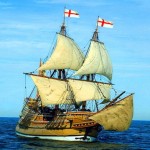 Lately, I have been looking in Ancestry.com, at immigration records for many of my ancestors. As I looked at the different ships they sailed on and the different locations they came from, I began to wonder about what it was really like to immigrate back them. I decided to do some research on that subject, and I was amazed at some of what I found.
Lately, I have been looking in Ancestry.com, at immigration records for many of my ancestors. As I looked at the different ships they sailed on and the different locations they came from, I began to wonder about what it was really like to immigrate back them. I decided to do some research on that subject, and I was amazed at some of what I found.
Of course, the biggest obstacle they faced was the cost…especially for a family. What doesn’t sound like much to us today, was really a lot of money back in the 1800s, and before. My great grandfather, Carl Schuhmacher spent seven years saving the $50.00 that it cost for one person to go. Many times, the whole family would work to send one person over so they could see if the opportunities were really there, and then that person would work t pay for the rest of the family to come.
For people who had to travel in steerage class, the journey was going to be a rough one. There was no limit to the number of steerage tickets sold, and the cost was usually $30.00 per ticket, which tells me that maybe my great grandfather had not traveled in steerage class…which is a relief to me after what I have read. Since there was no limit to the steerage tickets sold, the people were packed into the steerage area like cattle. The cost to feed each one was about sixty cents a day, so they could potentially make a net profit of $45,000 to $60,000 for each crossing. This was money made at the expense of the health, welfare, and even lives of those steerage passengers…a fact that I find shocking to say the least!!
Even when the immigrant wasn’t in steerage, the rough weather often made everyone sick. I don’t think that ships back then had some of the stabilizing features ships have today, and since they were smaller, they were probably tossed around more. Not good if you get sea sick…or even if you normally don’t.
Immigrants were told to be at the docks a day ahead of the departure date, because they had to be examined by American doctors before they were allowed to board the ship. I have no idea where they waited if they didn’t get examined the day before they sailed. I also have to wonder if they had to be examined again when they arrived here, because so many of them were sick on the ship that I would still think they brought disease to America.
Arrival in America didn’t necessarily mean they were set either. Because of language differences and strange sounding names, they were often subject to verbal abuse and discrimination. To fit in they would need to learn 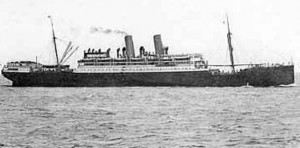 English…something I do agree with, although I don’t agree with discrimination or verbal abuse…or any other kind of abuse. I think they needed someone to teach them, without belittling them. Most wanted to fit in, but didn’t know how to learn English, or simply didn’t have a way to learn it.
English…something I do agree with, although I don’t agree with discrimination or verbal abuse…or any other kind of abuse. I think they needed someone to teach them, without belittling them. Most wanted to fit in, but didn’t know how to learn English, or simply didn’t have a way to learn it.
Any time you make a decision to move to another country, it is a life changing decision, but in those days, it was a much bigger change than it is these days. Had it not been for necessity, due to famine and poverty in their ow country, I have to wonder just how many people would have taken the risk.
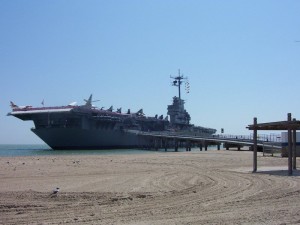
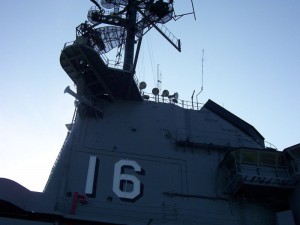 While Bob and I were in Texas on vacation in April of 2006, we had the wonderful opportunity to visit the USS Lexington…The Blue Ghost. This ship has a long and interesting history, and one I didn’t really know all that much about when I visited the ship. The ship we saw is not the original USS Lexington, but rather the one that replaced the original. The USS Lexington that we saw has an amazing history too…it is, in fact, a legend that was named for the American Revolution’s Battle of Lexington. On December 5, 1941, the original USS Lexington, which was one of the two largest aircraft carriers the United States had during World War II, was making its way across the Pacific in order to carry a squadron of dive bombers to defend Midway Island from an anticipated Japanese attack. The attack they anticipated did occur, but not where it had been expected. The attack was lodged on Pearl Harbor instead. The USS Lexington turned around and headed for Pearl Harbor, arriving on December 13th. That Lexington was later sunk.
While Bob and I were in Texas on vacation in April of 2006, we had the wonderful opportunity to visit the USS Lexington…The Blue Ghost. This ship has a long and interesting history, and one I didn’t really know all that much about when I visited the ship. The ship we saw is not the original USS Lexington, but rather the one that replaced the original. The USS Lexington that we saw has an amazing history too…it is, in fact, a legend that was named for the American Revolution’s Battle of Lexington. On December 5, 1941, the original USS Lexington, which was one of the two largest aircraft carriers the United States had during World War II, was making its way across the Pacific in order to carry a squadron of dive bombers to defend Midway Island from an anticipated Japanese attack. The attack they anticipated did occur, but not where it had been expected. The attack was lodged on Pearl Harbor instead. The USS Lexington turned around and headed for Pearl Harbor, arriving on December 13th. That Lexington was later sunk.
In early May, the first USS Lexington returned to the South Pacific to assist the USS Yorktown to fight against the Japanese offensive in the Coral Sea. On May 7th and 8th of 1942 planes from the USS Lexington helped sink the small Japanese aircraft carrier Shoho and participated in attacks on the large carriers Shokaku and Zuikaku. But, she was a major target of Japanese carrier planes and received two torpedo and three bomb hits. Initially, it appeared that the damage control efforts were successful, but she was racked by gasoline explosions early on the afternoon of May 8th. The fires were out of control, and it was clear that the Lexington was breathing her last breath. The ship was abandoned by her crew and it sunk. It was the first US aircraft carrier to be lost in World War II.
The second Lexington began its journey into fame on February 17, 1943, and it would serve longer and set more records than any other carrier in US Naval history. Originally to be named the Cabot, the name was changed after the sinking of the original Lexington in the Coral Sea. The Lexington became a part of the Fifth Fleet at Pearl Harbor. The ship took part in nearly every major operation in the Pacific Theater, serving 21 months in combat. It was here that the Lexington became famous in her own right. The Japanese radio station, the Tokyo Rose was always spreading rumors and propaganda. The station declared the Lexington sunk at least four times, but was proven wrong at the next battle, when the Lexington returned to the fight. I guess it must have been in an effort to save face that the Tokyo Rose dubbed the Lexington The Blue Ghost, indicating that it was a ghost ship returning to haunt the Japanese again and again. All the hard work paid off in the end though. The Lexington participated in the Great Marianas Turkey Shoot, the Battle of Leyte Gulf, and the Battle of the Philippine Sea. She received the Presidential Unit Citation and 11 Battle Stars during her service in World War II, and she was the first battleship into Tokyo Harbor for the Japanese peace treaty signing.
By the time we visited the second USS Lexington, she had been a museum since October of 1992. The ship had been decommissioned in August of 1990, after serving as a training ship for naval aviators in Pensacola, Florida since 1962. She was moved to her permanent location in Corpus Christi, Texas in January of 1992. We had the wonderful opportunity to explore the ship to our hearts’ content while we were there. It was quite interesting to us. I didn’t know much about how things were on a ship, but I found myself amazed over and over again. The way the crew lived, seemed so archaic to me, but I suppose that anyone who has ever served on a ship would tell me that it was all very normal. Finding your way around seemed so difficult to me, and I know we would have been lost repeatedly, had they not marked the directions with arrows on the floor and walls. It was hard to imagine just what being on board this ship in the midst of a battle must have felt. I don’t think anyone goes to war without a measure of fear. Nevertheless, there was no going back for the men, and later, women who 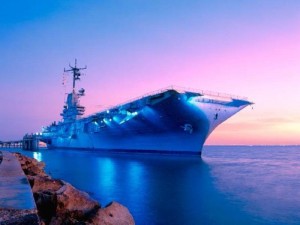
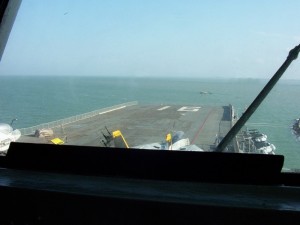 served on the Lexington. The Lexington was the first aircraft carrier to have women stationed on board. These men and women served courageously and honorably, some giving their lives on the Lexington fighting the battles that were laid out before her. Knowing the history of this great ship leaves me with an entirely new perspective about what an awesome ship it was, and it makes me glad I had the opportunity to tour the USS Lexington.
served on the Lexington. The Lexington was the first aircraft carrier to have women stationed on board. These men and women served courageously and honorably, some giving their lives on the Lexington fighting the battles that were laid out before her. Knowing the history of this great ship leaves me with an entirely new perspective about what an awesome ship it was, and it makes me glad I had the opportunity to tour the USS Lexington.
 As a kid, I was probably…different than lots of other kids. While most of my friends were listening to rock and roll, I was too, but I also liked things that were different, like Jonathan Livingston Seagull, by Richard Bach. When Neil Diamond did his narration, I found the story line very fascinating. Here was a seagull that wanted something different from life. He didn’t want the boring everyday existence, but the extraordinary. That was how I felt. It was quite easy to relate to Jonathan’s desire for excellence and yes, even greatness. He wanted to be remembered for doing something different, and like most pioneers, he was not appreciated for his efforts. The flock was disgusted with him, and threatened to throw him out. His parents were humiliated…horrified even, that their son wanted to be so different. That could sound like lots of parents today, but thankfully not my own, who wanted their daughters to be whatever they chose to be.
As a kid, I was probably…different than lots of other kids. While most of my friends were listening to rock and roll, I was too, but I also liked things that were different, like Jonathan Livingston Seagull, by Richard Bach. When Neil Diamond did his narration, I found the story line very fascinating. Here was a seagull that wanted something different from life. He didn’t want the boring everyday existence, but the extraordinary. That was how I felt. It was quite easy to relate to Jonathan’s desire for excellence and yes, even greatness. He wanted to be remembered for doing something different, and like most pioneers, he was not appreciated for his efforts. The flock was disgusted with him, and threatened to throw him out. His parents were humiliated…horrified even, that their son wanted to be so different. That could sound like lots of parents today, but thankfully not my own, who wanted their daughters to be whatever they chose to be.
I have always loved to watch seagulls. Most of the ones I could watch…around the fast food joints in Casper, Wyoming, were of the same old boring race for food variety, but when you get out on the ocean…and watch them from a ship, it’s a very different thing indeed. Those  birds, much like Jonathan Livingston Seagull enjoy flying for the pure enjoyment of flight. I love watching them soar and glide across the sky and swoop down to glide just above the face of the water. As we sailed along, they keep the pace with the ship, almost like they are trying to stay close to the people on board. These were gulls who were doing un-gull-like things. Now, I know that none of these gulls was the famous Jonathan Livingston Seagull, but I have to think that one or two of them might be aspiring to be the next Jonathan Livingston Seagull. Maybe even a modern day Jonathan Livingston Seagull, who maybe goes by John Seagull, because those full names are so stuffy anyway.
birds, much like Jonathan Livingston Seagull enjoy flying for the pure enjoyment of flight. I love watching them soar and glide across the sky and swoop down to glide just above the face of the water. As we sailed along, they keep the pace with the ship, almost like they are trying to stay close to the people on board. These were gulls who were doing un-gull-like things. Now, I know that none of these gulls was the famous Jonathan Livingston Seagull, but I have to think that one or two of them might be aspiring to be the next Jonathan Livingston Seagull. Maybe even a modern day Jonathan Livingston Seagull, who maybe goes by John Seagull, because those full names are so stuffy anyway.
There were lots of seagulls on our trip…the kind who went out by the fishing boats hoping for scraps of food, of course. There were also the ones who hunted for their own food, gliding low over the water, and then swooping down into the water hoping to catch their prey. They even hung out around the whales, although I have no idea what they were hoping to gain by that. Perhaps they thought the whales might stir up the fish, bringing them to the surface for easier hunting. While these gulls were doing what normal gulls do…hunting for food. They were not extraordinary and they were certainly not unique.

The gulls that loved flight were something so different, however. Yes, they swooped into the water for food too, but it did not seem to be the only thing they cared about. Watching them soar across the sky, or try to keep up with the ship, holding their position so they could look into the windows at the passengers, was so interesting. You would think that the ship, or at least the passengers would scare the birds, but they seem drawn to them. It’s almost like they are showing off. Like Jonathan Livingston Seagull, they seem to be shooting for something outside the norm. And that is what draws my attention to them too.
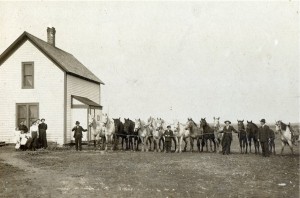 I have heard quite often about a trip that my great grandfather, Carl Schumacher took back to the old country…Germany. As far as I know it was the only trip he ever took back there to see his family and also spend some time with my great grandmother, Henriette’s family. The trip was taken in 1907, when my Great Aunt Bertie was just 8 years old. Grandpa wanted to show his family that he was doing well, as was his family, and show them his family, since they had never met them. He had a picture that was taken in front of the house with the women standing there, and the 14 horses they owned at the time along side. The men were holding the horses, and at the end of the line was Albert “trying to hold down” his horse, Beauty, which only he and Mina dared to ride. As it turned out, his family thought that his family must be rich, to own so many horses. They thought it was the right decision to move to America. They must have thought it was easy to get rich in America, when in reality, they weren’t wealthy. The family had what they had because of hard work and a little frugality.
I have heard quite often about a trip that my great grandfather, Carl Schumacher took back to the old country…Germany. As far as I know it was the only trip he ever took back there to see his family and also spend some time with my great grandmother, Henriette’s family. The trip was taken in 1907, when my Great Aunt Bertie was just 8 years old. Grandpa wanted to show his family that he was doing well, as was his family, and show them his family, since they had never met them. He had a picture that was taken in front of the house with the women standing there, and the 14 horses they owned at the time along side. The men were holding the horses, and at the end of the line was Albert “trying to hold down” his horse, Beauty, which only he and Mina dared to ride. As it turned out, his family thought that his family must be rich, to own so many horses. They thought it was the right decision to move to America. They must have thought it was easy to get rich in America, when in reality, they weren’t wealthy. The family had what they had because of hard work and a little frugality.
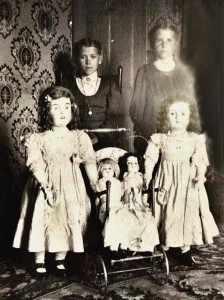
In all, my great grandfather would spend three months in Germany. That is a long time to be away from his family, but it made perfect sense, because getting there was not a quick trip in itself. Traveling by ship both ways was a slow mode of travel, so it made no sense to go if you weren’t going to stay a while. Upon his return, my Great Aunt Bertie went off by herself for a few minutes. She needed to cry a little for the joy of having him back. But while she needed a little cry to release the pent up loneliness she had been feeling, she was also very excited about the things he brought with him. The family back in Germany wanted to send some gifts back for the family with him, and they were magnificent. While Bertie only tells of the things she and Elsa received, I can imagine that the gifts for the rest of the family were equally magnificent.
Nevertheless, everyone was excited about the dolls that were sent for Bertie and Elsa. The dolls were three feet tall with human hair. They were beautifully dressed in pale blue dresses made by a dressmaker in Germany. They had little cloth bracelets of lace at their wrists, and their hands moved separately from the arms. The dresses were trimmed everywhere with tucks and lace of pale blue. On their feet were baby stockings and real leather slippers. The dolls were so big that Bertie and Elsa really couldn’t easily play with them, so they were given 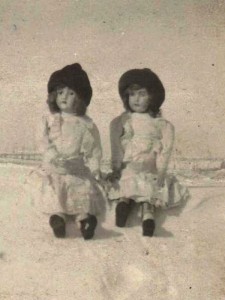 a special place in the parlor, where everyone could see and enjoy their beauty. When Bertie and Elsa moved to Colorado, many years later, they were unable to take the dolls with them, so they donated the dolls to a Crippled Children’s Home near Jamestown, North Dakota. The dolls were completely renovated and beautifully dressed, and were locked in a glass case for viewing only.
a special place in the parlor, where everyone could see and enjoy their beauty. When Bertie and Elsa moved to Colorado, many years later, they were unable to take the dolls with them, so they donated the dolls to a Crippled Children’s Home near Jamestown, North Dakota. The dolls were completely renovated and beautifully dressed, and were locked in a glass case for viewing only.
I have to wonder if my great aunts were a little sad when the donated their dolls, for while they were children anymore, the dolls were such a special gift, and had come from so far and with so much love that it must have been like leaving a little bit of their hearts behind too. Still, they must have brought much joy and happiness to the children who got to look at them.

